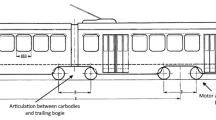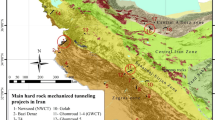Abstract
Since the development of tunnel construction technology, different tunnel excavation technologies have also been derived for different conditions. The safety diagnosis before the TBM mining method is particularly important. With the technology of safety diagnosis, the excavation process has the following effects on the tunnel engineering work. Great guarantee. The purpose of this paper is to study the excavation process of tunnel machinery for safety diagnosis before mining by TBM. It mainly includes step excavation method, full-section excavation method, guide pit excavation method and other technologies. This article uses a city subway construction project as an example to discuss in-depth the study of tunnel machinery excavation technology before the safety diagnosis of the mining method. The specific project is a city subway line with a total length of about 25.464 km and a total of 22 stations, including 9 transfer station. Based on field engineering experiments, the problems encountered in tunnel mechanical excavation are studied. The experimental data show that the results obtained through engineering tests can guarantee the safe and stable construction of the tunnel project, and the safety rate can reach 90%. The experimental results show that the obtained results can ensure the safety of tunnel mechanical excavation.





Similar content being viewed by others
References
Li F, Xiao M, Zhang J et al (2017) Health risk assessment on tunnel workers’ exposure to PM10 based on triangular fuzzy numbers. In: AIP conference proceedings, vol 1820, no 1. AIP Publishing LLC, p 040011
Sturk R, Olsson L, Johansson J (2015) Risk and decision analysis for large projects as applied to the Stockholm ring road tunneling. Tunn Undergr Space 11(2):157–164
Heinz D (2016) Challenges to tunneling engineers. Tunn Undergr 11(1):5–10
Kampmann J, Eskesen SD (2016) Summers risk assessment helps select the contractor for the Copenhagen Metro System. In: Proceedings of the World Tunnel Congress 98 on Tunnels and Metropolises, no 1, pp 123–128
Greblicki W, Pawlak M (2017) Hammerstein system identification with the nearest neighbor algorithm. IEEE Trans Inf Theory 63(8):4746–4757
Poudel J, Wang L, Anastasio M (2019) Iterative image reconstruction algorithm for transcranial photoacoustic tomography applications. J Acoust Soc Am 145(3):1858
Arahal MR, Martin C, Barrero F (2019) Assessing variable sampling time controllers for five-phase induction motor drives. IEEE Trans Ind Electron PP(99):1
Chapman CB (2015) Design engineering a need to rethink the solution using knowledge based engineering. Knowl-Based Syst 12(6):257–267
Vike EA (2016) Experiences from environmental risk management of chemical grouting agents used during construction of the Romeriksporten tunnel. Tunn Undergr Space Technol 15(4):369–378
Yoshida Y (2020) Portfolio optimization in fuzzy asset management with coherent risk measures derived from risk averse utility. Neural Comput Appl 32:10847–10857
Aneziris ON, Papazoglou IA, Kallianiotis D (2015) Occupational risk of tunneling construction. Saf Sci 48(8):964–972
Beard AN (2015) Tunnel safetyrisk assessment and decision-making. Tunn Undergr Space Technol 25(1):91–95
Nyvlt O, Privaral S (2015) Probabilistic risk assessment of highway tunnels. Tunn Undergr Space Technol 26(1):71–82
Das S, Choudhury S (2020) Evaluation of effective stiffness of RC column sections by support vector regression approach. Neural Comput Appl 32:6997–7007
Cuevas E, Díaz P, Avalos O (2017) Nonlinear system identification based on ANFIS-Hammerstein model using Gravitational search algorithm. Appl Intell 48(11):182–203
Du J, Zhang L, Chen J et al (2019) Multi-model predictive control of Hammerstein-Wiener systems based on balanced multi-model partition. Math Comput Model Dyn Syst 25(4):333–353
Eyoh I, John R, Maere GD (2018) Hybrid learning for interval type-2 intuitionistic fuzzy logic systems as applied to identification and prediction problems. IEEE Trans Fuzzy Syst PP(99):1
Guruswamy A, Blum R (2016) Ambiguity optimization for frequency-hopping waveforms in MIMO radars with arbitrary antenna separations. IEEE Signal Process Lett 23(9):1231–1235
Deligiannis A, Panoui A, Lambotharan S (2017) Game-theoretic power allocation and the Nash equilibrium analysis for a multistatic MIMO radar network. IEEE Trans Signal Process PP(99):1
Yan J, Liu H, Pu W (2016) Joint beam selection and power allocation for multiple target tracking in netted colocated MIMO radar system. IEEE Trans Signal Process PP(99):1
Avila FR, Duarte LT, Biscainho LWP (2017) On the sparsity-based identification and compensation of Hammerstein systems. IEEE Signal Process Lett PP(99):1
Khachatryan KA, Terdzhyan TÉ, Sardanyan TG (2017) On the solvability of one system of nonlinear Hammerstein-type integral equations on the semiaxis. Ukr Math J 69(3):1287–1305
Guo J, Liu H (2017) Hammerstein system identification with quantised inputs and quantised output observations. IET Control Theory Appl 11(4):593–599
Zhu C, Li Q (2018) Disparity refinement iterative algorithm based on gradient domain guided image filtering. Tianjin Daxue Xuebao (Ziran Kexue yu Gongcheng Jishu Ban)/J Tianjin Univ Sci Technol 51(6):638–644
Acknowledgements
This paper has been supported by National Natural Science of China (Grant No. 41572358).
Author information
Authors and Affiliations
Corresponding authors
Ethics declarations
Conflict of interest
There no potential competing interests in our paper. And all authors have seen the manuscript and approved to submit to your journal. We confirm that the content of the manuscript has not been published or submitted for publication elsewhere.
Additional information
Publisher's Note
Springer Nature remains neutral with regard to jurisdictional claims in published maps and institutional affiliations.
Rights and permissions
About this article
Cite this article
Wei, M., Song, Y., Wang, X. et al. Safety diagnosis of TBM for tunnel excavation and its effect on engineering. Neural Comput & Applic 33, 997–1005 (2021). https://doi.org/10.1007/s00521-020-05371-y
Received:
Accepted:
Published:
Issue Date:
DOI: https://doi.org/10.1007/s00521-020-05371-y




